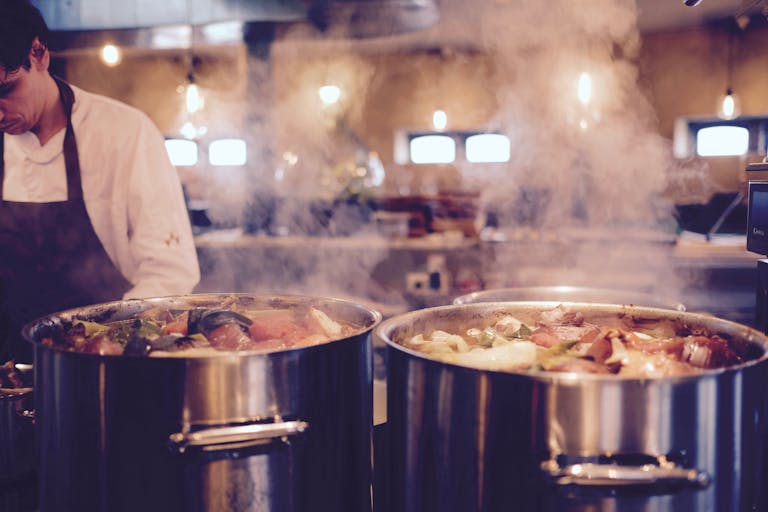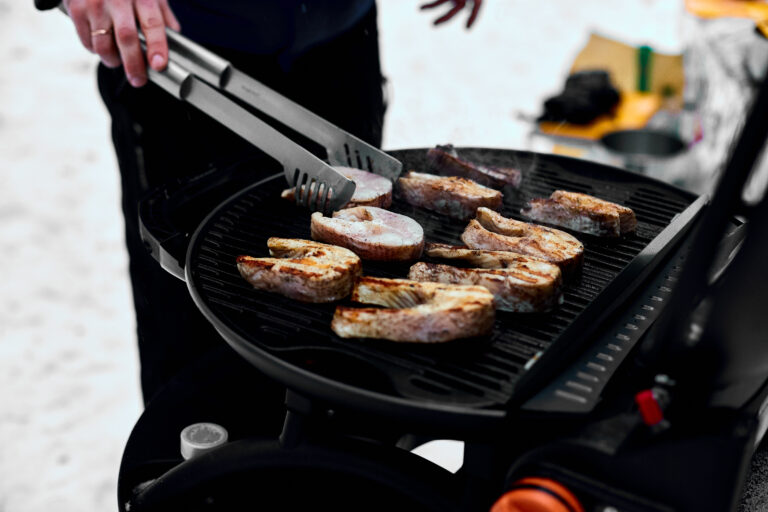6 Charcoal Grilling Tips You Need for Perfect BBQ Results
Master charcoal grilling with essential tools and techniques for perfect BBQ results, from lighting methods to cooking temperatures and maintenance tips.

Mastering charcoal grilling might seem daunting, but with the right tips, you’ll be a backyard BBQ hero in no time. Let’s dive into the essentials to make your grilling experience fun and flavorful.
Disclosure: As an Amazon Associate, this site earns from qualifying purchases. Thank you!
Understanding the Basics of Charcoal Grilling

Charcoal grilling may initially seem intimidating, but with the right knowledge, you’ll be grilling like a pro in no time.
Key Equipment Needed for Charcoal Grilling
- Charcoal Grill: Invest in a quality charcoal grill. Look for one with adjustable vents and a sturdy build.
- Charcoal Chimney Starter: Ensures your coals heat evenly and without chemicals. It’s a must-have for quick, uniform lighting.
- Long-handled Tongs: Keeps your hands safe from heat while allowing better control of your food.
- Grill Brush: Cleans your grill grates effectively. A clean grill ensures better-tasting food.
- Meat Thermometer: Guarantees your food is cooked to a safe temperature. Precision avoids undercooking or overcooking.
- Lump Charcoal: Made from pure wood, it burns hotter and faster. It provides a natural smoky flavor and is best for high-heat searing.
- Charcoal Briquettes: Made from wood by-products and additives, they burn longer and maintain a steady temperature. Ideal for low-and-slow cooking like BBQ ribs.
Note: Use natural lump charcoal for authentic taste; use briquettes for consistent heat.
By understanding these fundamentals, you’re setting the foundation for successful charcoal grilling.
Setting Up Your Charcoal Grill

Choosing the Right Location
Place your grill on a flat, stable surface to prevent tipping. Situate it at least 10 feet from any structure, including your house and overhanging branches. Ensure there’s plenty of ventilation, avoiding closed spaces like garages.
Safety Measures to Consider
Keep a fire extinguisher or bucket of sand nearby in case of emergencies. Check the grill for any propane leaks if it’s a combination grill. Supervise children and pets, keeping them at a safe distance from the grilling area. Always use grilling tools with long handles to avoid burns.
Lighting Techniques for Charcoal Grills

Mastering the art of lighting your charcoal grill is key to achieving that perfect BBQ flavor.
Using a Chimney Starter
- Fill the Chimney: Load it with charcoal. Lump charcoal is best for a quick, high-heat fire, while briquettes offer steady, long-lasting heat.
- Add Newspaper: Place crumpled newspaper or a fire starter under the chimney. Light it to ignite the charcoal.
- Wait for Ash: Let it burn until the coals are ashy—usually about 15-20 minutes.
- Pour into Grill: Carefully pour the hot coals into the grill. Use long-handled tongs to arrange them.
Using Lighter Fluid
- Arrange Charcoal: Pile charcoal into a pyramid shape in the grill.
- Apply Lighter Fluid: Sprinkle lighter fluid evenly but avoid soaking. Excessive fluid can give food a chemical taste.
- Let it Sit: Wait for about a minute to allow the lighter fluid to soak in.
- Ignite and Wait: Use a match or lighter to ignite the charcoal. Wait until the coals are ashy—about 20 minutes—before spreading them evenly.
These techniques ensure efficient and safe lighting for your charcoal grill, setting the stage for a delicious BBQ.
Mastering Temperature Control
Controlling grill temperature is key for perfect BBQ results. Here’s how to do it right:
Adjusting Air Flow
Control airflow to manage heat levels. Open vents fully to increase temperature. Close them slightly to lower them. Monitor changes carefully.
Using Charcoal Arrangement for Heat Zones
Use a two-zone setup for versatility. Pile more charcoal on one side for high-heat searing, and fewer on the other for indirect cooking. This arrangement lets you handle different foods simultaneously.
In the video, StatUpBox explains –
- Start with Less Charcoal: Begin with a smaller amount of charcoal and add more as needed to avoid overheating.
- Chimney Starter Method: Use a chimney starter for easy and consistent charcoal ignition.
- Snake Method for Low Temperatures: Utilize the snake method for prolonged, even heat at lower temperatures.
- Grill Spacing: Maintain a 60-40 ratio of empty space to charcoal to avoid overly high direct heat and flare-ups.
- Use of Liquid Pan: Place a pan with water or other liquids to maintain moisture and facilitate even heat distribution.
- Initial Temperature Check: Allow the grill to stabilize after closing it to determine the starting temperature.
- Two-Way Thermometer: Use a two-way thermometer to monitor both grill temperature and meat internal temperature.
- Vent Control for Temperature: Adjust vents to control airflow and thus regulate the grill temperature.
- Top and Bottom Vent Interaction: Coordinate opening and closing of vents to manage airflow and heat intensity.
- Practice and Experiment: Fine-tune temperature control by adjusting vents incrementally based on temperature fluctuations.
Essential Charcoal Grilling Tools and Accessories

Mastering charcoal grilling requires the right gear. Here are the essentials you need to get started.
Must-Have Grilling Tools for Beginners
- Chimney Starter: Light your charcoal quickly and evenly.
- Grill Tongs: Handle hot food and coals safely.
- Grill Brush: Keep your grates clean and food tasting fresh.
- Instant-Read Thermometer: Check meat temperatures for perfect doneness.
- Heat-Resistant Gloves: Protect your hands from high temperatures.
- Charcoal Rake: Adjust and distribute coals with ease.
- Wood Chips: Add smoky flavors, like hickory or applewood. Soak them in water before use.
- Rub Spices: Use dry rubs to enhance meat with a burst of flavor.
- Marinades: Infuse your meat with moisture and taste by marinating ahead of time.
Equip yourself with these tools and accessories, and you’ll be ready to conquer your charcoal grilling endeavors.
Cooking Time and Techniques

Grilling with charcoal takes skill and practice. Knowing how to manage cooking times and techniques will ensure your food is grilled to perfection.
Understanding the Timing for Different Foods
- Burgers and Hot Dogs: Cook for 4-5 minutes per side. Use direct heat for a crispy exterior.
- Chicken Breasts: Grill for 6-8 minutes per side over medium heat to avoid drying out.
- Steaks: Aim for 4-6 minutes per side for medium-rare. Use high heat for a good sear.
- Fish Fillets: Cook for 3-5 minutes per side on medium-high heat. Oil the grates to prevent sticking.
- Vegetables: Grill for 5-10 minutes, turning occasionally. Use a basket for smaller pieces.
- Meat Thermometer: Insert into the thickest part. Aim for 165°F for chicken, 145°F for pork, and 135°F for medium-rare steak.
- Finger Test: Press the meat; it should feel like the fleshy part of your palm for medium-rare.
- Visual Cues: Look for juices running clear in poultry and an opaque color in fish.
Maintenance Tips for Your Charcoal Grill

Keeping your charcoal grill in top shape ensures better performance and longevity. Follow these essential tips.
Regular Cleaning Methods
- Use soapy water: Scrub the grill grates with soapy water and a stiff brush after each use.
- Empty the ash: Remove ash and debris from the bottom of the grill to prevent buildup.
- Clean the interior: Use a grill brush to clean the inside of the lid and bowl to remove grease and food particles.
- Oil the grates: Lightly oil the grates after cleaning to prevent rust and sticking.
Storing Your Charcoal Grill Properly
- Cover it up: Use a high-quality grill cover to protect against the elements.
- Store indoors: When not in use for long periods, store your grill in a garage or shed.
- Keep it dry: Ensure the grill is dry before storing it to prevent rust and corrosion.
- Protect from pests: Make sure no food residues are left to avoid attracting insects or rodents.
Common Mistakes to Avoid in Charcoal Grilling

Knowing what to avoid can save you from common pitfalls. Here are two key mistakes to watch out for.
- Don’t over-grill your food. This can lead to a burnt exterior and dry interior. Use a meat thermometer to check doneness, especially for thicker cuts.
- Avoid under-grilling. This mistake’s the opposite, it leaves your food unsafe to eat. Remember to keep an eye on cooking times and use visual cues to gauge readiness.
- Avoid ignoring weather conditions. Wind and rain can affect grill temperature and cooking times. Set up a windbreak or grill in a sheltered area to maintain consistent heat.
- Don’t forget to adjust for ambient temperature. Colder days may require more charcoal or longer cooking times. Plan accordingly to avoid surprises.
Frequently Asked Questions
How can I effectively light a charcoal grill?
Use a chimney starter for easy and efficient lighting. Fill it with charcoal and light a fire starter under it. Once the coals are ashy and glowing, pour them into the grill.
What tools are essential for charcoal grilling?
Basic tools include a chimney starter, grill tongs, a spatula, a meat thermometer, and a grill brush. Add a basting brush and grilling gloves for more advanced grilling.
How do I control the temperature on a charcoal grill?
Adjust the air vents. Opening the vents increases the temperature while closing them decreases it. Also, arrange coals to create direct and indirect heat zones.
What are the recommended cooking times for various foods?
Thin meats like burgers and hot dogs take about 5-10 minutes. Thicker cuts like chicken breasts and ribs may require 20-30 minutes or more. Always use a meat thermometer for accuracy.
What are common mistakes to avoid in charcoal grilling?
Avoid over-grilling and under-grilling. Use a meat thermometer for precision. Also, don’t overcrowd the grill, and let the grill preheat before cooking.
Are there any good resources for improving my charcoal grilling?
Yes, recommended books include “Franklin Barbecue: A Meat-Smoking Manifesto” and “Meathead: The Science of Great Barbecue and Grilling.” Check YouTube channels like “BBQ Pit Boys” and “Cooking with Ry” for helpful videos.
How do grilling apps help?
Apps like the Weber® iGrill App and BBQ Pro help monitor temperatures and provide recipes. They are excellent for both beginners and seasoned grillers to enhance their performance.
Which websites offer in-depth charcoal grilling advice?
Websites like Serious Eats and AmazingRibs.com offer expert analyses, tips, and detailed articles to help improve your grilling skills.






